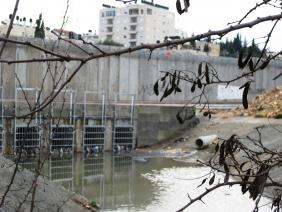Easing Measures for the Palestinians - Collapse of a City
With the closing of the gate between Dahiat el Barid ( Post-Office Suburb in Arabic) and the dismantling of Ar-Ram checkpoint, the former was cut off from the town of Ar-Ram. The Ministry of Defense was quick to announce: "Facilities granted to the Palestinians: Ar-Ram checkpoint to be removed . . . " (Walla News 18.2.09), followed by "the removal of a checkpoint is a significant easing measure, one of various now granted by the defense system to the Palestinian population in Judea & Samaria".
Ar-Ram is the largest and most densely populated town in northern Jerusalem, on the crossroads between Ramallah and East Jerusalem; there are some high-standard secondary schools attended by students from the surrounding villages as well. It used to abound with shops and stores, all manner of essential services including medical ones, and everything that an urban center can offer, including sources of livelihood for the inhabitants of the area.
These so-called eased measures have turned Ar-Ram into an enclave, and thousands of residents of the entire area found themselves cut off from the metropolis that had been the hub of their life for centuries, and gave them access to East Jerusalem. For hundreds of thousands of people, the separation-wall encircling Ar-Ram from south, east and wet, completed the urban dissection that began with the annexation of vast Palestinian territories to form an area as emptied of Palestinians as possible, tagged by the Israeli government "Greater Jerusalem".
The geographical proximity that made possible a quick access to East Jerusalem is now no more than an illusion. If previously inhabitants of the area could get to the city with a mere brief walk, they must now travel hours to reach their workplaces and their urban services. We're talking about the inhabitants of Qalandiya, Kufr Akeb and Semiramis, many of whom carry Jerusalem IDs, pay municipal taxes (but do not enjoy urban and other services). Other places, such as Bir Naballah, formerly inhabited by 30,000 people, suffer from mass emigration now that the wall is enclosing them. The remaining now number a few thousand only. Many buildings are abandoned, and without a central governing body to assume responsibility, crime and lawbreaking abound, poverty thrives as well as drug-dealing.
The results of the new reality in Ar-Ram and environment, from the reports:
Hundreds of children, making their way to school in the morning and back home at lunchtime, a short distance that should take a few minutes only, are forced to make a detour of many kilometers, have to be checked at Qalandiya checkpoint and as a result are very late for school. (Ar-Ram 8.3.09)
And worst of all: a considerable number of families, holding Palestinian IDs, discovered that they are "illegals" in their own homes and are liable to be deported. (Ar-Ram 1.3.09)
A headline from the London Guardian:
"Israel actively pursuing the illegal annexation". ( A-Ram 7.3.09)
From a report by Ilana Hammerman, also appeared as an article in Haaretz:

. . . Now the inhabitants of Ar-Ram are cut off completely from the public and private space that used to be their living-space: from schools, hospitals, workplaces, from family and friends. This wall with its host of facilities, literally crawling in the middle of the street, also sends its long arms of rules and regulations into homes and flats and thus separates fathers from their children, husbands from their wives: those who carry blue IDs and are allowed to be here, and those who carry green IDs and must be there. The visitor from that other planet will also be able to see the remains of the openings that until a few months ago allowed children and adults to sneak through, while to the border-policemen turned a blind eye, to shorten the way to school or workplace: here (I saw with my own eyes) they passed, stooping inside large sewage pipes, now covered with heavy iron bars, locked and bolted, and here the skinny ones - mainly children - squeezed through a narrow gap separating an iron gate from the wall, which is now blocked with all manner of iron sheets and metal pieces . . . (Ar-Ram 22.2.09)
Tamar Fleishman
Translated: Elinor Berger
